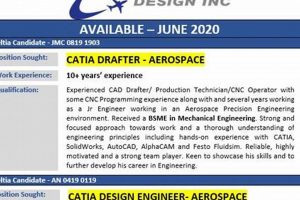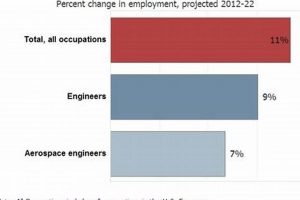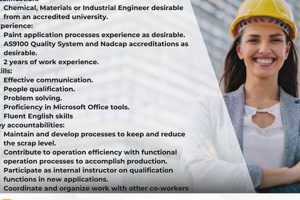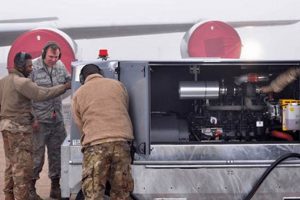This document outlines the responsibilities, required skills, and qualifications for a professional who validates the performance and safety of aircraft, spacecraft, and related systems. It provides a framework for understanding the role’s scope and the expectations placed upon the individual filling it. For example, such a document might detail the necessity for proficiency in data acquisition systems, structural testing methodologies, or knowledge of relevant industry regulations.
The significance of a well-defined document lies in its ability to attract qualified candidates, ensure consistent performance evaluation, and mitigate potential risks associated with inadequate system validation. Historically, these specifications have evolved alongside technological advancements in the aerospace sector, reflecting increasing complexity and stringency in testing protocols.
The following sections will delve into the typical elements contained within these role specifications, including responsibilities, essential competencies, educational requirements, and key performance indicators.
Tips for Crafting an Effective Specification Document
The following recommendations aim to improve the clarity, accuracy, and impact of role specifications, ultimately leading to better candidate selection and performance within the aerospace testing domain.
Tip 1: Clearly Define Responsibilities: The document should explicitly state the day-to-day tasks and long-term projects the engineer will be responsible for. For example, indicate if the role involves designing test setups, analyzing data, writing reports, or collaborating with other engineering teams.
Tip 2: Specify Required Technical Skills: List the specific technical competencies necessary for success, such as proficiency in particular software packages (e.g., MATLAB, LabVIEW), knowledge of testing standards (e.g., MIL-STD-810), or expertise in specific testing methods (e.g., vibration analysis, thermal testing).
Tip 3: Outline Educational and Certification Requirements: Clearly state the minimum required educational qualifications (e.g., Bachelor’s degree in Aerospace Engineering) and any preferred certifications (e.g., Professional Engineer license). Consider specifying acceptable alternative degrees with relevant experience.
Tip 4: Emphasize Soft Skills: Highlight the importance of non-technical skills, such as communication, problem-solving, teamwork, and attention to detail. Provide examples of how these skills are crucial in the context of aerospace testing.
Tip 5: Include Performance Metrics: Define measurable performance indicators that will be used to evaluate the engineer’s success. This could include metrics related to test completion rates, accuracy of data analysis, or adherence to safety protocols.
Tip 6: Use Clear and Concise Language: Avoid jargon and technical terms that may not be understood by all applicants. Ensure the document is well-organized, easy to read, and free of grammatical errors.
Tip 7: Align with Company Culture: Reflect the company’s values and culture in the language and tone of the document. This helps attract candidates who are a good fit for the organization.
By implementing these tips, organizations can develop robust specifications that effectively communicate expectations, attract top talent, and ultimately contribute to the success of aerospace testing programs.
The subsequent sections will explore specific examples of exemplary specification documents and highlight common pitfalls to avoid.
1. Responsibilities
The clearly defined duties within a specification document for an aerospace test engineer serve as the cornerstone of the position. They dictate the daily activities and projects undertaken by the individual, directly influencing the success of testing programs. A well-articulated set of responsibilities ensures candidates understand the scope of the work and allows for accurate performance evaluation. For example, a specification document might state that the engineer is responsible for “designing and implementing vibration testing procedures for aircraft components” or “analyzing thermal test data to identify potential design flaws.” These specific declarations guide the engineer’s actions and contribute to the overall objective of ensuring the safety and reliability of aerospace systems.
Without a comprehensive description of responsibilities, confusion and inefficiency can arise. Engineers may misinterpret their role, leading to duplicated efforts or overlooked tasks. Consider a scenario where the specification document vaguely states the engineer is responsible for “data analysis.” This ambiguity could result in inconsistent data processing, flawed conclusions, and ultimately, compromised system validation. A more detailed description, such as “analyzing strain gauge data using finite element analysis software to assess structural integrity,” provides clarity and reduces the risk of errors.
Therefore, defining responsibilities within an aerospace test engineer specification document is not merely a formality but a crucial element for effective operation. Clear articulation prevents misunderstandings, promotes accountability, and ultimately contributes to the safety and reliability of aerospace vehicles and systems. It serves as a foundational element, aligning individual efforts with overall organizational objectives and mitigating potential risks associated with ambiguous role definitions.
2. Qualifications
The ‘Qualifications’ section within an aerospace test engineer job description is directly linked to the effective execution of responsibilities and achievement of defined performance metrics. It serves as a filter, ensuring that candidates possess the foundational knowledge and skills necessary to perform the required tasks. Inadequate qualifications can lead to compromised testing procedures, inaccurate data analysis, and potentially catastrophic consequences in the operation of aerospace systems. For instance, a job specification might require a Bachelor’s degree in Aerospace Engineering or a related field, coupled with several years of experience in a relevant testing environment. This is not an arbitrary requirement, but a recognition that the complex nature of aerospace testing demands a robust understanding of aerodynamics, materials science, and structural mechanics.
The specific qualifications detailed in a job role also dictate the level of supervision and training required. A candidate with advanced degrees or specialized certifications, such as a Professional Engineer (PE) license, may require less oversight than a recent graduate. Furthermore, specialized experience in areas like vibration testing, electromagnetic interference (EMI) testing, or non-destructive testing (NDT) can significantly impact the candidate’s suitability for a particular role. For example, a project involving the validation of a new satellite communication system would necessitate expertise in radio frequency (RF) testing methodologies, as well as a thorough understanding of relevant industry standards and regulations.
Ultimately, the ‘Qualifications’ component of the job role determines the candidate’s ability to contribute effectively to the organization’s goals. It’s not merely a checklist of degrees and certifications, but a critical assessment of the individual’s capacity to apply their knowledge and skills to real-world challenges. Neglecting the importance of properly defining qualification requirements can lead to hiring unsuitable candidates, resulting in increased training costs, reduced productivity, and potentially compromised safety. Therefore, a meticulously crafted qualifications section is essential for attracting qualified professionals and ensuring the success of aerospace testing endeavors.
3. Technical Skills
Technical skills constitute a critical component of any effective specification. They represent the specific, demonstrable abilities that enable an engineer to perform the tasks associated with validating aerospace systems. A detailed delineation of required skills directly affects the quality of candidates attracted and their subsequent performance on the job. For example, proficiency in data acquisition systems is essential for collecting accurate measurements during testing, and expertise in specific software packages, such as MATLAB or LabVIEW, is often necessary for data analysis and modeling. A failure to adequately define these skills can result in the hiring of individuals who lack the necessary competencies, leading to delays, errors, and potentially compromised safety.
The technical skills outlined are closely tied to the responsibilities detailed in the role specification. If the role requires the engineer to design and implement vibration testing procedures, then expertise in vibration analysis, modal analysis, and related testing standards becomes paramount. Similarly, if the engineer is responsible for analyzing thermal test data, then proficiency in heat transfer principles, finite element analysis (FEA) software, and thermal measurement techniques is crucial. Examples of specific skills might include the ability to operate and interpret data from spectrum analyzers, oscilloscopes, and environmental test chambers. The specification should clearly articulate the level of proficiency required for each skill, ranging from basic understanding to expert-level knowledge.
In summary, the rigorous definition of technical skills within an specification is paramount for ensuring the successful operation of aerospace testing programs. It directly impacts the selection of qualified personnel and their ability to perform essential tasks accurately and efficiently. Neglecting this aspect can lead to inefficiencies, increased risks, and ultimately, a failure to meet the stringent safety and performance requirements of the aerospace industry. The alignment between skills and responsibilities is a key element in a robust .
4. Testing Protocols
Testing protocols are foundational to the aerospace industry and, consequently, a critical component of the profession’s role definition. The role necessitates a thorough understanding and strict adherence to established testing protocols to ensure the safety, reliability, and performance of aircraft, spacecraft, and related systems. Deviation from these protocols can have severe consequences, ranging from equipment failure to catastrophic accidents. Thus, the individuals ability to interpret, implement, and document testing procedures is a core expectation detailed within the professional’s specification.
The inclusion of specific testing standards, such as MIL-STD-810 for environmental testing or DO-160 for airborne equipment, serves as a benchmark for evaluating a candidate’s qualifications. The specification will often detail the specific types of tests the engineer will be responsible for, including vibration analysis, thermal testing, electromagnetic interference (EMI) testing, and structural integrity assessments. For instance, if the role involves testing the flight control systems of an aircraft, the individual must be proficient in conducting hardware-in-the-loop (HIL) simulations and real-time testing to validate the system’s response to various flight conditions. Furthermore, the engineer is expected to document any deviations from standard testing protocols and justify the rationale for such changes.
In summary, the importance of testing protocols within the document cannot be overstated. This highlights the role’s crucial position in upholding the rigorous standards demanded by the aerospace sector. Proficiency in this area ensures the engineer is equipped to contribute meaningfully to the safety and reliability of flight systems, mitigating risks and contributing to overall project success. A comprehensive understanding is not merely an advantage but a fundamental requirement for competent performance in the specified field.
5. Reporting
Reporting forms a critical, integral element within the domain of aerospace testing, directly influencing safety, regulatory compliance, and informed decision-making. The ability to accurately and comprehensively document test results is a core expectation for individuals in this field.
- Data Accuracy and Integrity
Precise recording and verification of test data is paramount. Measurement errors or inconsistencies can lead to flawed analyses, incorrect conclusions, and potentially unsafe systems. Accurate reporting includes meticulous record-keeping, calibration verification, and adherence to established data validation protocols. Examples include recording sensor readings during vibration tests or documenting the precise conditions during thermal cycling. Improper data handling, conversely, might lead to acceptance of a faulty component or system.
- Clarity and Conciseness
Reports must be easily understood by a variety of stakeholders, including engineers, managers, and regulatory agencies. A well-written report avoids jargon, presents data in a logical and organized manner, and clearly articulates findings and conclusions. For example, a report summarizing the results of a structural test should include clear diagrams, concise descriptions of the testing methodology, and unambiguous statements regarding the structural integrity of the component under test. Ambiguous or poorly written reports can lead to misinterpretations and delays in the development process.
- Compliance and Traceability
Aerospace testing is subject to stringent regulatory requirements, and reports must demonstrate compliance with applicable standards and regulations. This includes documenting the testing procedures used, the equipment employed, and the results obtained. Traceability is also essential, allowing stakeholders to verify the origins of data and the validity of conclusions. For instance, reports must reference the specific standards (e.g., MIL-STD, DO-160) against which the testing was performed, and they must identify the specific equipment used, including serial numbers and calibration dates. Failure to demonstrate compliance and traceability can result in rejection of the product by regulatory agencies.
- Failure Analysis and Corrective Actions
Reporting extends beyond simply documenting successful tests. It is equally important to thoroughly investigate and document failures, identifying the root causes and proposing corrective actions. Failure analysis reports should include detailed descriptions of the failure mode, photographic evidence, and a proposed solution to prevent future occurrences. For example, a report detailing a failure during a fatigue test might identify a specific stress concentration point in the component’s design and recommend modifications to reduce stress levels. Comprehensive failure reporting enables continuous improvement and prevents recurring issues.
These facets underscore the critical role of reporting in the aerospace testing process. Effective reporting ensures the integrity of test data, facilitates clear communication, demonstrates regulatory compliance, and promotes continuous improvement, all of which are essential for ensuring the safety and reliability of aerospace vehicles and systems. The ability to generate high-quality reports is, therefore, a fundamental requirement for individuals in this field.
Frequently Asked Questions Regarding Aerospace Test Engineer Specifications
The following questions and answers address common inquiries concerning the creation and interpretation of aerospace testing role specifications. The information presented aims to provide clarity and guidance to employers and prospective candidates navigating the nuances of this critical aspect of aerospace engineering.
Question 1: What level of detail should be included when defining responsibilities?
Responsibilities should be delineated with sufficient specificity to provide a clear understanding of the day-to-day tasks and long-term projects the engineer will undertake. Vague descriptions should be avoided in favor of actionable statements that outline specific activities and expected outcomes.
Question 2: Is it necessary to list specific software packages or testing equipment in the skills section?
Yes, listing specific software and equipment is highly recommended. This provides candidates with a clear understanding of the technical tools they will be expected to use and allows them to accurately assess their own qualifications. This specificity also aids in filtering applications to identify candidates with the most relevant experience.
Question 3: How important are soft skills in comparison to technical skills?
While technical skills are essential, soft skills, such as communication, problem-solving, and teamwork, are equally important. The aerospace industry relies on collaborative efforts, and the ability to effectively communicate technical information to both technical and non-technical audiences is critical for project success. Soft skills directly impact team dynamics, project efficiency, and overall organizational performance.
Question 4: What is the best way to define performance metrics for an aerospace test engineer?
Performance metrics should be specific, measurable, achievable, relevant, and time-bound (SMART). Examples include metrics related to test completion rates, accuracy of data analysis, adherence to safety protocols, and the number of identified and resolved system defects. The metrics should align with the overall goals and objectives of the testing program.
Question 5: How frequently should a specification be reviewed and updated?
Specifications should be reviewed and updated regularly, at least annually, to reflect changes in technology, industry standards, and organizational needs. Significant changes in the role’s responsibilities or required skills should trigger an immediate review. Maintaining an up-to-date specification ensures that it remains relevant and effective in attracting qualified candidates.
Question 6: What is the role of certifications in the qualifications section?
Relevant certifications, such as a Professional Engineer (PE) license or certifications related to specific testing methodologies (e.g., vibration analysis, non-destructive testing), can serve as valuable indicators of a candidate’s competence and experience. These certifications demonstrate a commitment to professional development and adherence to industry standards. Specifying preferred certifications can help identify candidates with a proven track record of expertise.
The information provided offers key insights into crafting effective aerospace testing specifications. Adherence to these guidelines will significantly improve candidate selection and contribute to the success of aerospace testing endeavors.
The following segment will delve into potential pitfalls to avoid when writing role specifications, further enhancing the effectiveness of the document.
Aerospace Test Engineer Job Description
The preceding exposition has illuminated the critical components within an “aerospace test engineer job description.” It underscored the necessity for precisely defined responsibilities, clearly articulated qualifications, a comprehensive outline of required technical skills, strict adherence to testing protocols, and the essential practice of detailed reporting. The effective construction and utilization of this document are paramount to attracting qualified personnel and maintaining the stringent safety and performance standards mandated by the aerospace sector.
Moving forward, continuous refinement of these specifications is essential to adapt to evolving technologies and industry demands. Emphasis on clear communication and comprehensive documentation will ensure the continued success of aerospace testing endeavors, safeguarding the reliability and integrity of flight systems for generations to come. Organizations must invest in developing robust specifications to secure a skilled workforce capable of meeting the challenges of the ever-advancing aerospace landscape. The information found in these specifications directly contributes to the continued advancement and safety of air and space travel.







